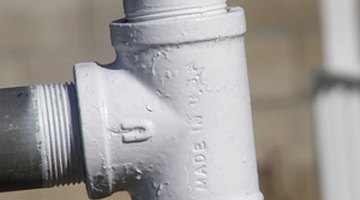How to Repair a Steam Pipe
Many older homes use steam radiators as the primary means to distribute heat. Radiators remain a relatively efficient way to heat a house (if the furnace providing the steam is itself efficient), but since most radiator heat systems are fairly old, it is common for them to develop a number of problems, including buildup within the steam release valves, buildup of water from condensation in the steam pipes, and knocking sounds as they heat and cool. Many of these problems can be fixed by replacing sections of pipe, which for steam heat is usually black iron piping.

Step 1
Turn off the furnace, and allow the radiator system to cool completely.
Step 2
Cut out the leaking part of the pipe with the pipe cutter, and use cutting oil to protect the blades.
Step 3
Measure and cut a length of new pipe 1 inch shorter than the piece you removed, to allow for 1 inch of threading at each of the unions.
Step 4
Burr the ends of the new pipe to make them less sharp.
Step 5
Place the length of pipe in the vise, and use a pipe-threading tool on each end of the pipe. Turn the threading tool until it has threaded its entire length on the outside the pipe. Cutting oil will help make this process easier and will protect the threading tool.
Step 6
Burr each of the ends of the gap in the old pipe.
Step 7
Thread each of the ends of the gap in the old pipe, holding onto the old pipe with a pipe wrench to prevent too much twisting as you turn the threading tool.
Step 8
Wipe off the end of each newly threaded pipe with a rag to remove the sharp metal filings.
Step 9
Wrap the new thread on each end of the new length of pipe in Teflon tape, and attach an iron union on each end fitting with a matching thread. Screw the union onto the pipe.
Step 10
Wrap each end of the new thread on the old pipe with Teflon tape, and screw the new pipe into place, one end at a time, using one pipe wrench to hold the old pipe, and one to screw the new pipe into place by holding onto the union. You may need to flex the old pipe a little bit to get the new section into place; this is normal.
References
Writer Bio
After working as an editorial assistant for the University of Chicago Press, Dario Saandvik began writing in 2009. He specializes in gardening, home maintenance and computer software. Saandvik has a Bachelor of Arts in English from the University of Chicago and is in the graduate program for English literature at the University of Wisconsin-Madison.
Photo Credits
- pipe fitting image by Joann Cooper from Fotolia.com
More Articles



